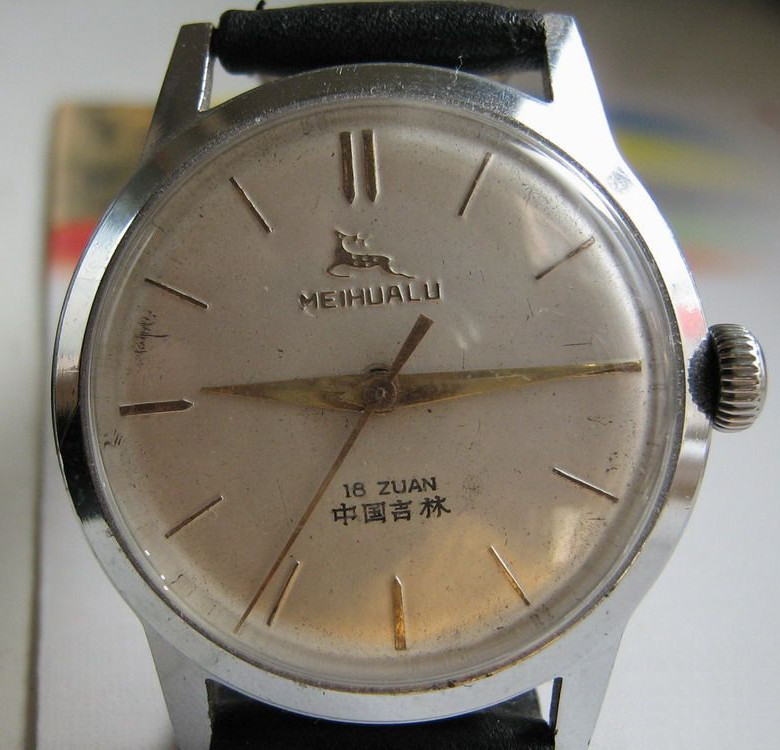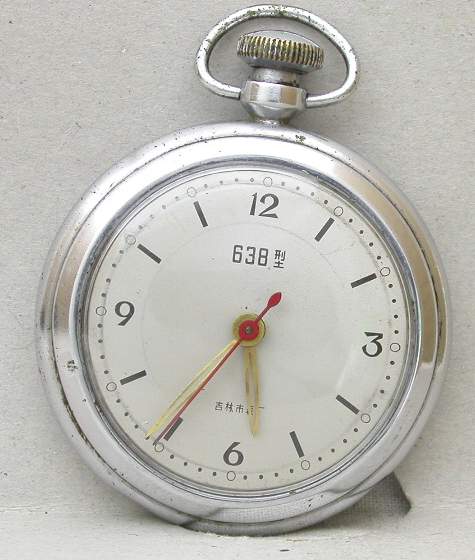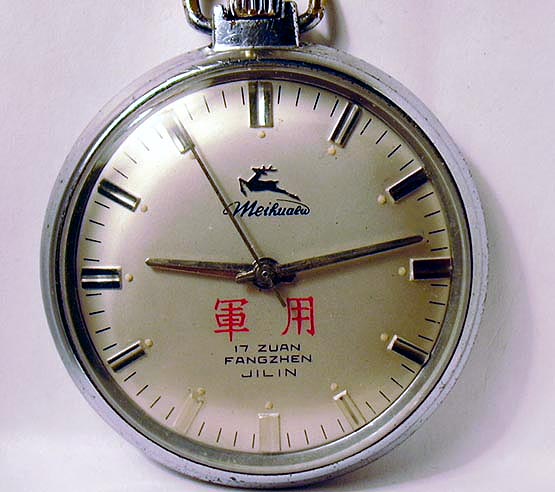Jilin Watch Factory
Jilin Watch Factory (吉林手表厂, see below for alternative names) was founded in 1958 in
Jilin City
in
Jilin Province
, as one of the eight original Chinese watch factories founded that year. After a brief early period manufacturing wristwatches, the factory's primary focus shifted to producing pocket watches, starting with the
638
model. In its early years, Jilin also produced a number of clocks and timing devices for military use. In the 1970s, focus shifted to civilian goods, including pocket watches powered by an oversized version of the
Chinese Standard Movement
, known as the
HJ1A
. Later in the decade, wrist watch production resumed and regular sized versions of the standard movement were manufactured with the factory code ZJL. The factory's main brand was
Meihualu
(Sika deer), which was used from the earliest days, but a number of other brands were used, especially for standard movement wristwatches, including
Jilin
,
Hangtian
and
Jixing
. The factory did not fare well during the crisis that faced China's watch industry in the late 1980s and the 1990s, and Jilin Watch Factory declared bankruptcy in 1999.
Contents
History
Founding and early output
Jilin Watch Factory was founded in October of 1958, as a merger of several watch and clock repair collectives from the nearby cities of Jilin and Changchun (the old and new capitals of the province, respectively), totalling 138 workers. The name of the factory can be a cause of confusion: initially named Jilin City Watch and Clock Factory (吉林市钟表制造厂), the name was changed in 1960 to Jilin City Watch, Clock and Industrial Equipment Company (吉林市钟表仪器工业公司). However in the context of watch production it was typically referred to as either Jilin City Watch Factory (吉林市表厂) or later simply Jilin Watch Factory (吉林手表厂), with both of these names appearing on dials and casebacks.
Little is known about the earliest output of Jilin Watch Factory, other than that it included wood-cased pendulum clocks with a 7 day power reserve, a 17-jewel wristwatch movement which was either a clone or close derivative of an unknown Enicar movement completed by a small 9 person team, and a pocket watch movement which was either a clone or close derivaive of an unknown Soviet design. In 1960, production machinery was transferred from Changchun Meteorological Instrument Factory (长春市气象仪器厂) to Jilin, and the factory began producing a local version of the ST2 movement used in Tianjin Watch Factory 's WuYi branded watches. The watches containing these movements were branded either Jilin or Meihualu , the later featuring a logo of a Sika Deer. Due to delays in setting up the new equipment, only 142 of these watches had been made when, in 1962, the Ministry of Light Industry instructed Jilin to cease trial production of wristwatches and focus instead on a pocket watch movement, in response to a perceived deficit of domestic pocket watch production. These early Jilin and Meihualu watches are therefore extremely rare, although both brands were resurrected in the 1970s for more extensively produced products.
The first pocket watch to have apparently been mass-produced by Jilin was a local version of the 584 pin-lever design developed by the Shanghai ZuanShi Watch Factory in 1958. The first five trial movements were manufactured in August 1963, and so the movement was designated 638 . The 638 movement consisted of 91 parts, and 87 of these were produced at the Jilin factory, the remaining 4 being purchased elsewhere. In October of the same year, the Ministry of Light Industry approved the 638 for mass production, and allocated a budget of 6.88 million Yuan to facilitate the production of 638 as well as 100,000 stopwatches (presumably of 593 type, but this is not known for certain) of and 10,000 military instruments (see below). 638 production continued until 1972, with a total of 33,583 being produced.
Military projects
During the 1960s, Jilin was a major supplier of timing devices to the People's Liberation Army. One such project, project 307, was a timing device derived from the 638 pocket watch movement. In the years after China's communist revolution, the People's Republic of China on the mainland and the Republic of China on Taiwain engaged in a propaganda war , and one of the techniques employed by both sides was to drop propaganda leaflets from balloons flown over the other's territory. The project 307 timer was developed for this purpose. Envisaged as a cheap, reliable and disposable device, the 307 has no complex functions and its sole purpose was to close an electric circuit after a preset time had elapsed, triggering the release of the leaflets. After a trial production run of some 73 units, the device was not put into mass production for various reasons. Nevertheless, factory employee Wang Gensheng received a "May 1" Labor Medal in recognition of significant contributions to the development of the 307 timer.
Other projects included: project 201, a clock or timing device associated with tanks, about which little is known; project 105, a heavily waterproofed and shock-protected marine clock for installation onboard PLAN speedboats; project 301, an aviation clock for installation in the cockpits of PLAAF fighters; and project 302, a smaller and simpler version of the project 301 clock which did away with the integrated flight timer and stopwatch. The 105 and 301 clocks were originally developed at Shanghai Watch Factory 's "608 workshop", which specialised in military and security projects. Jilin had also produced a smaller, less featureful version of the 301 clock, called the 302, which may have been developed locally.
In the 1970s, the factory's focus began to shift away from military work and toward production of wristwatches and pocket watches for civilian use. By 1972, all military projects had ceased except for projects 105 and 302. Jilin's close ties to the military continued, however, with the best examples of their civilian watches often being designed for military use.
The Standard Movement at Jilin
In the 1970s, production at almost all Chinese watch factories shifted to focus on the newly developed Tongji or Chinese Standard Movement . Jilin was no exception, although this time there was a twist. In July 1971, development work had began on a jewelled pocket watch movement designated JH2, which was probably intended as a higher quality successor to the 638. However, with the design of the standard movement finalised in November of the same year, JH2 development appears to have been cancelled very early on, leaving the movement exceptionally rare and mysterious. The JH2 effort was superceded by development of an over-sized version of the standard movement designed for use in pocket watches, designated HJ1A . By July of 1972, the HJ1A was complete: essentially a Tongji enlarged to a diameter of 35.3mm, the movement had a reduced beat rate of 18,000 BPH and an increased power reserve of 40 hours. It was the first and last jewelled movement designed specifically for pocket watch use in China. Production began immediately, and from 1972 to 1975 the city of Jilin invested 2.21 million Yuan to expand and rebuild the factory, installing major new equipment, some of which was imported. Eventually, 200,000 HJ1A pocket watches were being produced every year.
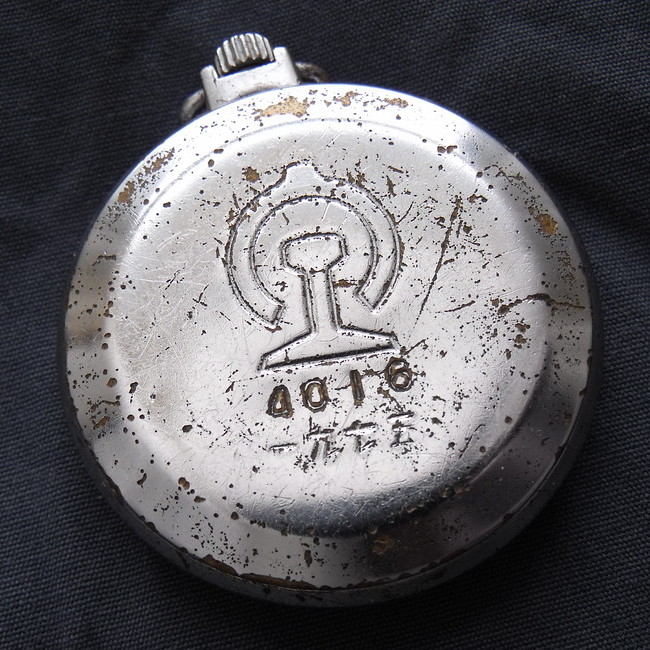
These pocket watches were branded Meihualu, the return of the short-lived brand used for the ST2 watches produced in the factory's early days, albeit with a simplified logo. Dials were typically white or silver, and occasionally textured. Much rarer were black dialed pocket watches, and reports exist of just a single red dialed example. The highest quality watches were hand selected for railway and military use and these were given special customised dials or casebacks reflecting their intended purpose. Some military models featured luminous paint on the hands and dial. The Meihualu pocket watches were initially very popular and sold well. Up until 1975, demand for the pocket watches outstripped supply, but in 1976 a balance was struck. In 1977 interest in the product began to decline, and by 1978 the factory had a backstock of over 20,000 unsold watches. Despite the obvious decrease in demand, the rigidly planned economy left Jilin with no choice but to continue production. Eventually, department stores in Jilin province began refusing to accept delivery of further watches and in 1979 production of the HJ1A finally ceased. Roughly one million units were made in total.
Later, surveys were conducted to determine the cause for the decline in demand. A main motivation for the government's push to increase domestic pocket watch production at the start of the 1970s was to outfit railway and mining workers, whose demanding work environments made wristwatches impractical. However, during the 70s many of China's steam locomotives were replaced by diesel or electric models, and the mining industry underwent substantial mechanisation. With fewer workers shovelling coal or swinging pickaxes, the need for pocket watches which could be more easily kept out of harm's way decreased. As for the civilian market, over the decade the standard of living had improved to the point where many people were willing to pay the slightly higher price for a wristwatch to enjoy the increased convenience over a pocket watch.
Fortunately, in 1976, just before demand for pocket watches began to die off, Jilin began preparing to manufacture wristwatches again, for the first time since 1962. Jilin's version of the regular sized standard movement was designated ZJL1 and trial production began in 1977, with 12,000 watches produced that year. A further 18,400 watches were produced in 1978, and in the same year the Ministry of Light Industry declared that national quality standards had been met. Mass production was approved in 1979, the same year HJ1A production ceased, and ZJL1 production for that year increased to 153,339. Production of standard movement wrist watches became the factory's main focus, however in order to make good use of the vast stock of unsold HJ1A movements, in 1979 Jilin also began to produce oversized wristwatches using the pocket watch sized standard movement. These watches sold at only a slightly higher price than the original Meihualu pocket watches had and proved quite popular. Half way into 1980, the HJ1A backstock had been cleared and the short production run of these unique watches ended.
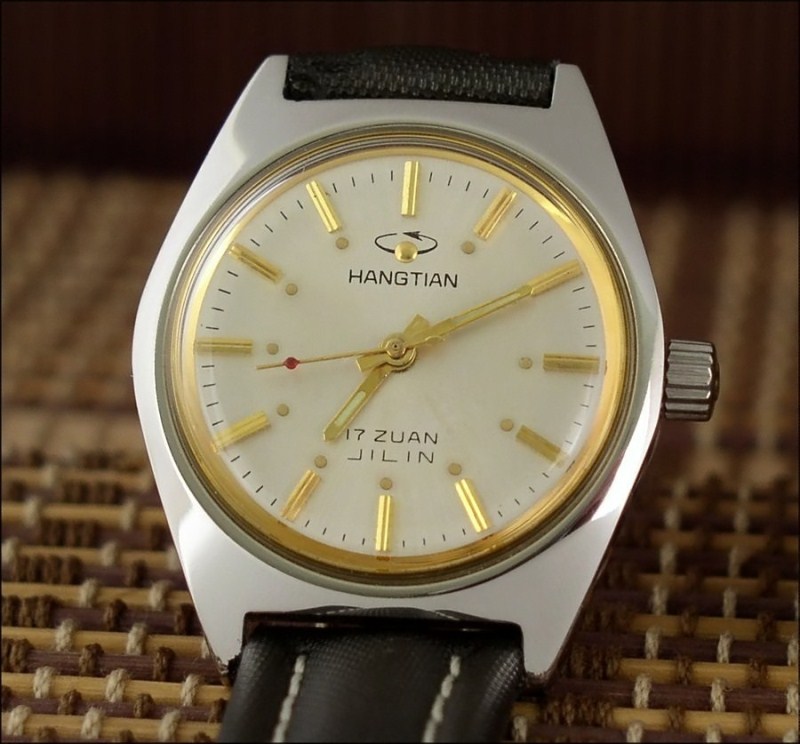

As the factory's focus shifted to standard movement wristwatches and production figures increased, several other brands were introduced alongside the long-standing Jilin and Meihualu, most prominently Hangtian and Jixing , but also Fuxing , Jinlu , Lonngzhu , Shenhua and Tianchi . Some Jixing watches were designated for military use and feature specially marked dials.
1980s
Having discarded its pocket watch heritage, Jilin prospered in the first half of the 1980s, with standard movement production reaching half a million units in the first year of the decade. A series of factory expansions and upgrades were delayed multiple times for various reasons, but were eventually completed by 1985. Despite these setbacks, during this time the factory introduced a small movement for use in women's watches, designated SJL3 . It is unknown which brand(s) were applied to watches using this movement. Furthermore, around 1983 Jilin began producing pocket watches with quartz movements. Branded Fushou , these used the DST5 movement developed at Tianjin (the second instance of technology transfer from Tianjin to Jilin, although it is unclear if the DST5 was actually manufactured at Jilin). In 1985, the Ministry of Light Industry presented Jilin with an award for outstanding new products.
Decline and bankruptcy
The late 80s and 90s were an extremely difficult time for most of the Chinese watch factories whose main output was the Chinese Standard Movement, and once again Jilin was no exception. Most of the original eight factories, being among the largest and most experienced factories, managed to avoid total collapse, but sadly Jilin did not. Despite attempting to move with the times by introducing a quartz movement in 1990 (designated DSJ2 , almost nothing is known about this movement), by the end of the decade the factory was in extreme financial trouble and was having difficulty paying its workers their wages. In 1999, on March 10th, Jilin Watch Factory declared bankruptcy, ending over 40 years of history. Its assets were eventually acquired by the Jilin Longding Group.
Factory codes
- Factory code: ZJL
- Possible factory codes: SJ, SLJ
Brands
External resources
English language
- watchuseek.com forum thread: A question for the vintage experts (much of the research for this Wiki page took place in this thread)
Chinese language
- 郇金光讲述.吉林市制表人物揭秘 【以及最早试制艰辛路程】 ("Huan Jinguang tells the story of Jilin City tabulation characters [and the first trial hard journey]")
- 国产“梅花鹿”怀表及其他 (Domestic "deer" pocket watch and other)
- 第一代中国仿苏航空/坦克钟 ("The first generation of Chinese imitation Soviet air / tank clock")
- 【手表知识】 国产军品之巅---105快艇钟(已增订) ("[Watch knowledge] the top of the domestic military --- 105 speed boat bell (updated)")
- 301航空时钟 ("301 aviation clock")
- 各位大神,我求《301型航空时钟修理》一书 (Great God, I seek "301 aviation clock repair" a book)
